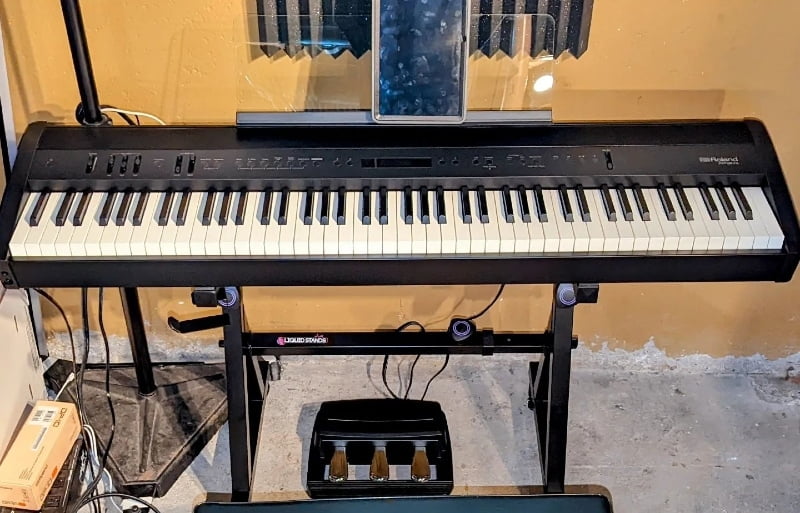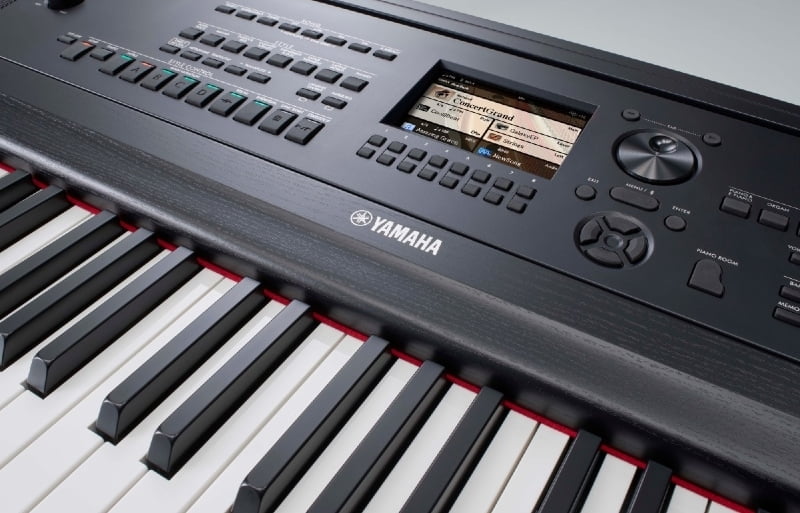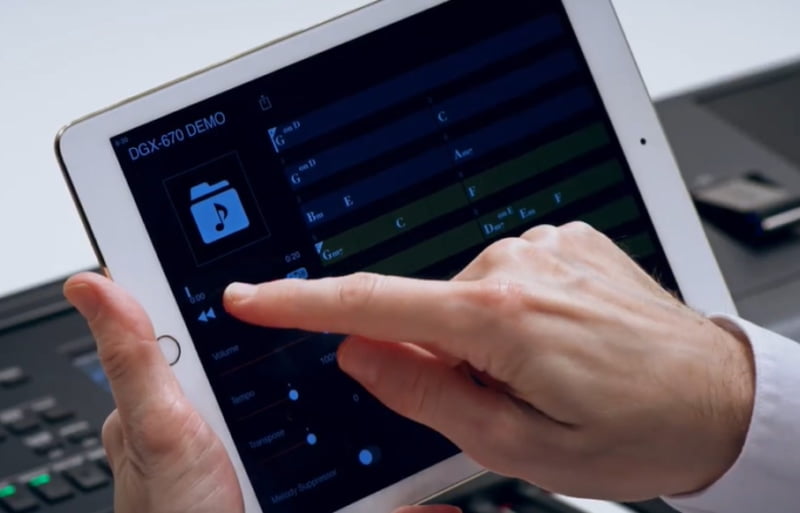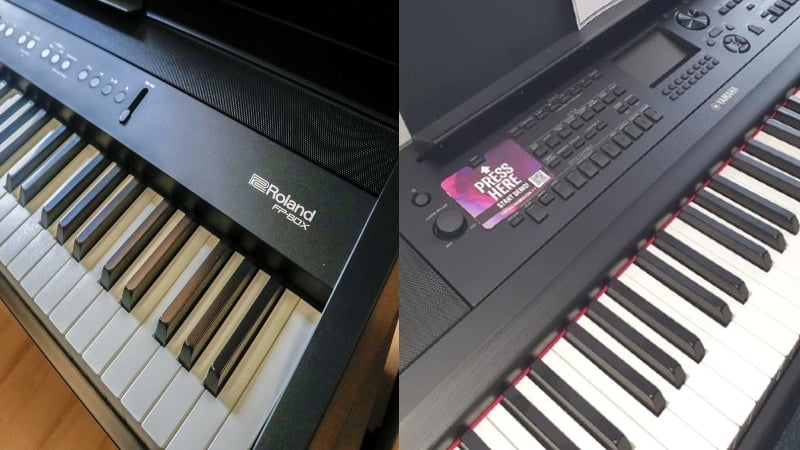Buying a new digital piano? Check out this Yamaha DGX 670 vs Roland FP 60x comparison to find out which model is the better fit for you!
Arranger pianos are true workhorse instruments. And two great examples of these pianos are the Yamaha DGX-670 and the Roland FP-60x. These instruments are designed for musicians and come with a host of features and functions that are ideal for playing live music.
But which model is better?
Well, that question can be complicated. And when I conducted my own Yamaha DGX-670 vs Roland FP-60x shootout, the Roland came out on top with a slim lead. These pianos were tied in just about every category, but in the end, the Roland had a small advantage.
If you want to learn which piano is the best for your needs, you’ve come to the right place. In this article, I’ll dive into everything I learned when testing these pianos and give my two cents on which piano might be the best for you.
Yamaha DGX 670 vs Roland FP 60x: Comparison Chart




Last update on 2025-07-11 / Affiliate links / Images from Amazon Product Advertising API
Yamaha DGX 670 vs Roland FP 60x: A Head-to-Head Comparison
The final score in this comparison was 3-2 in favor of the Roland FP-60x. The only area where I found it to be better than the Yamaha was how the piano felt. But other than that, both pianos offered many features that any pianist would love.
So, at the end of the day, it’s all a matter of preference. In this section, I’ll explain the details of the comparison and why the Roland FP-60x edged out a narrow win. And by the end, you’ll know exactly which piano fits your needs.
Feel
The winner: Roland FP-60x
As mentioned earlier, the Roland FP-60x only won this comparison because of the feel. And even in this category, the margins were incredibly small, and it could have gone either way. But because of the numerous touch sensitivity options, the Roland FP-60x came out on top.

+Hammer Action
Before anything, let’s talk about the hammer action because both of these pianos feature great hammer action systems. The DGX-670 comes with the Graded Hammer Standard of Yamaha. This is the most basic progressive hammer action system on Yamaha pianos, but it’s one of the best.
In fact, you can find this hammer action system on many Yamaha digital pianos because it’s affordable but can compete with any other premium option on the market. On top of that, the keys have a slight texture to them, which feels much closer to an acoustic piano than glossy keys.
The Roland FP-60x, on the other hand, has the PHA-4 system, which is one of Roland’s best options. This hammer action also features heavier keys on the bass side, and it feels very close to an acoustic piano.
But the reason the Roland came out on top was the adjustable key sensitivity. The Yamaha only features 5 types of touch sensitivity, while the Roland features over 100. So, if you want the slight nuance you can get with acoustic pianos, the Roland FP-60x does a much better job than the Yamaha DGX-670.
And because of this, the Roland FP-60x won the whole comparison, as these two pianos were tied for every other comparison point.
Tone
The winner: Tie
The next consideration I had was the tone. And as expected, the Yamaha and Roland both offered very realistic and high-quality piano tones. Since these are both premium options from the brands, you can expect them to have great sound quality. On top of that, they both have wide sound libraries, giving you many options for different musical styles.

+Tone Generator
The Yamaha DGX-670 uses the CFX sound engine. This is an engine packed with top-quality samples recorded from Yamaha CF Grand Pianos. The result is a very bright and balanced tone that’s very close to a real piano. In fact, out of a good system, this piano is about as close as you’ll get to a real acoustic sound at this price point.
The Roland, on the other hand, uses the SuperNatural Piano Sound. This is the brand’s equivalent to Yamaha’s CFX sound engine and performs about the same. You still get realistic piano tones with this instrument. However, take note that the Roland is more expensive than the Yamaha, so you’re paying more for more or less the same tone quality.
+Sound Library
Both of these pianos feature hundreds of tones. The Yamaha DGX-670 has a larger sound library with over 630 tones. However, not all of these tones come from the CFX Sound Engine so you can expect a slight dip in quality, especially with the drums, strings, synth, and SFX sound banks.
The Roland has a smaller library with only 358 tones. While this is significantly smaller than the Yamaha, it offers the same functionality. Even the most experienced pianists won’t use all 600 tones regularly, so the 358 from the Roland is more than decent.
So, regardless of which piano you choose, you can expect it to provide you with the variety you need for various musical styles.
Piano Features
The winner: Tie
Another area wherein these pianos were tied was the piano features. I couldn’t pick a winner as both instruments offered a wide range of features that are all very useful.
+Polyphony
To start, both pianos come with 256-note polyphony. This means that the pianos can play up to 256 samples at the same time. This is great if you’re using the sustain pedal to add expression to your playing, as you can keep stacking notes on top of each other and expect them to ring out.
On top of that, both these pianos feature playing modes where you can blend different voices. With such high maximum polyphony, you won’t have to worry about the pianos sounding muddy when using dual modes. And while this is a great feature, keep in mind that this is about what is expected from this price range.
+Effects
These pianos both have useful effects sets. You can adjust the ambiance, modulation, and even EQ of all the tones. However, the Yamaha still has a small advantage here because it comes with reverb effects, which were missing on the Roland FP-60x.

Yamaha DGX-670 vs Roland FP 60x: The Similarities
The main similarity that these pianos share is that they are arranger pianos. These are instruments specifically designed to have a lot of sounds and offer various modes to make it easier to play live music. This is also why these pianos are a bit more expensive than others in the range and why they are a favorite for performing pianists.
Aside from having all those pre-loaded sound banks, the instruments also feature pre-loaded songs. This allows you to play with a backing track and even load your own MIDI tracks to use when playing live. This is also why the pianos aren’t exactly for beginners but would make flexible investments for performing musicians.
Quick Rundown of the Yamaha DGX-670
- CFX Stereo Sampling faithfully reproduces the sound of Yamaha's flagship CFX Full Concert Grand.
- GHS weighted action is heavier in the low keys and lighter in the high keys, just like an acoustic piano. The special matte black key tops are designed to absorb moisture and remain tactile after extended use without becoming slippery.
- Adaptive Style automatically shifts between the Main Style Variations by changing your velocity and number of notes played.
- Unison and Accent function adds a doubled voice to your melody line and musical "hits" when you accent your notes.
- Smart Chord lets you play great-sounding chords from simple Pop triads to complex jazz 7th chords with just a few fingers.
Last update on 2025-07-11 / Affiliate links / Images from Amazon Product Advertising API
Quick Rundown of the Roland FP60x
- If you’re looking for pro performance without the flagship price, the FP-60X is for you.
- The midrange model in the FP-X series is a compact and elegant instrument that enhances any living space, backed by an array of features that will satisfy experienced players.
- Attractive modern look based on the award-winning design of the previous generation FP series
- SuperNATURAL Piano sound engine for rich expression, from pianissimo to fortissimo
- Specially curated onboard sounds ready for every musical genre, including electric pianos, organs, strings, and synthesizers
Last update on 2025-07-11 / Affiliate links / Images from Amazon Product Advertising API
Product Video
Related Articles to Yamaha Dgx 670
- Yamaha DGX-670 vs YDP 144: Finding the Best Digital Piano
- Yamaha DGX 670 vs Casio PX S3000: Which Piano Comes Out on Top?
- Yamaha P125 vs DGX 670: Which Piano Comes Out on Top?
- Yamaha DGX 670 Vs P515: Which Gives You Bang For Your Buck?
- Yamaha DGX 670 Vs 660: The Distinct Difference In Details You Need To Know About
- Yamaha DGX 670 Vs Roland FP 30x: Which Works Better For Your Needs?
References:
- Yamaha DGX-670: https://www.sweetwater.com/store/detail/DGX670BK–yamaha-dgx670b-88-key-black-portable-grand-includes-pa150-power-adapter-and-sustain-pedal-black
- Roland FP-60x: https://www.roland.com/global/products/fp-60x/
Lulacruza is an electronic folk duo operating at the junction of the hypermodern and the ancient. Our music weaves together hypnotic female singing, South American folk instruments and electronic processing, while channeling pulsating waves from the source of creation.
Lalucruza is also a community where you can connect with other music lovers to collaborate, exchange ideas and share knowledge. A platform for who wants to learns the basics of playing piano, guitar, drum masters’ technique, etc.. is the premise of our website.
